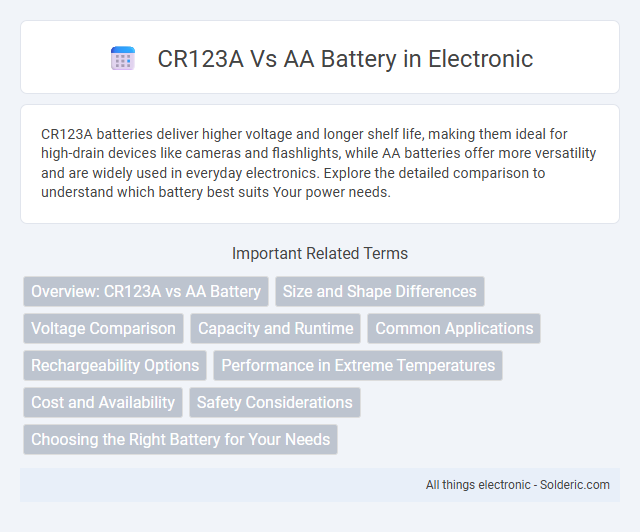CR123A batteries deliver higher voltage and longer shelf life, making them ideal for high-drain devices like cameras and flashlights, while AA batteries offer more versatility and are widely used in everyday electronics. Explore the detailed comparison to understand which battery best suits Your power needs.
Comparison Table
| Feature | CR123A Battery | AA Battery |
|---|---|---|
| Type | Lithium Primary | Alkaline or NiMH Rechargeable |
| Voltage | 3.0 Volts | 1.5 Volts (Alkaline), 1.2 Volts (NiMH) |
| Size (Diameter x Length) | 17mm x 34.5mm | 14.5mm x 50.5mm |
| Capacity | 1500 mAh (typical) | 1800-2600 mAh (Alkaline), 1600-2500 mAh (NiMH) |
| Weight | 17 grams | 23 grams (typical) |
| Common Uses | High-drain devices, cameras, flashlights, security systems | Household electronics, remote controls, toys |
| Rechargeable Options | No (primarily non-rechargeable) | Yes (NiMH rechargeable versions available) |
| Operating Temperature | -20degC to 60degC | 0degC to 50degC (Alkaline), -20degC to 60degC (NiMH) |
Overview: CR123A vs AA Battery
CR123A batteries are lithium-based cells primarily used in high-drain devices like cameras and tactical flashlights, offering 3 volts and a compact 34mm size. AA batteries are more versatile, available in alkaline, NiMH, and lithium chemistries, providing 1.5 volts (alkaline) and commonly used in household electronics. The CR123A delivers higher energy density and longer shelf life compared to standard AA batteries, making it ideal for specialized applications requiring reliable power.
Size and Shape Differences
CR123A batteries are cylindrical and measure approximately 34.5mm in length and 17mm in diameter, whereas AA batteries are slightly longer at about 50.5mm and narrower with a diameter of 14.5mm. The CR123A's compact size enables high energy density suitable for high-drain devices like cameras and tactical equipment. AA batteries, being slimmer and longer, are common in household electronics where moderate energy output and standard sizing are required.
Voltage Comparison
The CR123A battery typically provides a nominal voltage of 3 volts, which is twice the voltage of a standard AA battery at 1.5 volts. This higher voltage makes CR123A batteries ideal for high-drain devices such as cameras and flashlights requiring more power output. In contrast, AA batteries are commonly used in everyday electronics where lower voltage and longer runtime are sufficient.
Capacity and Runtime
CR123A batteries typically offer a higher capacity of around 1500mAh compared to AA batteries, which usually range from 1800mAh to 3000mAh depending on the type (alkaline or rechargeable NiMH). Despite the lower mAh rating, CR123A batteries deliver a higher voltage of 3V, resulting in longer runtime in high-drain devices such as cameras and tactical flashlights. AA batteries provide a more consistent performance for low to moderate drain electronics, but for high-power applications, CR123A's combination of voltage and capacity ensures superior runtime efficiency.
Common Applications
CR123A batteries are commonly used in high-drain devices such as tactical flashlights, security cameras, and smoke detectors due to their high energy density and compact size. AA batteries are more versatile and widely found in everyday household electronics, including remote controls, wall clocks, and portable toys, because of their standard size and moderate power output. Choosing between CR123A and AA batteries depends on the device's power requirements and physical compatibility.
Rechargeability Options
CR123A batteries are typically non-rechargeable lithium cells, offering high energy density but limited to single-use applications, whereas AA batteries come in both disposable alkaline and rechargeable NiMH (Nickel-Metal Hydride) varieties. Rechargeable AA batteries can be cycled hundreds of times, making them a cost-effective and environmentally friendly choice for frequent use. Your device's compatibility with rechargeable options depends largely on size specifications, but choosing rechargeable AA over CR123A reduces long-term waste and expense.
Performance in Extreme Temperatures
CR123A batteries outperform AA batteries in extreme temperatures, maintaining a stable voltage range from -40degC to 60degC, which makes them ideal for outdoor and high-demand devices. AA batteries, particularly alkaline types, begin to lose capacity rapidly below freezing, often failing to deliver sufficient power in subzero conditions. Lithium-based AA variants improve low-temperature performance but still fall short of the consistent reliability offered by CR123A cells in harsh environments.
Cost and Availability
CR123A batteries generally cost more than AA batteries due to their specialized lithium chemistry and higher energy density. AA batteries are widely available and typically less expensive, making them the preferred choice for everyday devices. Your decision may depend on budget constraints and whether you're powering high-drain electronics that benefit from the longer lifespan of CR123A cells.
Safety Considerations
CR123A batteries have a higher voltage (3V) compared to AA batteries (1.5V), necessitating careful device compatibility checks to prevent damage or leakage. The lithium-based chemistry of CR123A demands strict adherence to storage and handling guidelines to avoid risks like overheating or combustion. AA batteries, typically alkaline or NiMH, pose lower safety risks but still require proper disposal to prevent environmental harm and potential leakage.
Choosing the Right Battery for Your Needs
CR123A batteries offer higher voltage (3V) and greater energy density, making them ideal for high-drain devices like cameras and tactical flashlights, while AA batteries provide 1.5V and are widely compatible with everyday electronics such as remote controls and clocks. Selecting the right battery depends on the device's voltage requirements, size constraints, and usage duration, with CR123A specializing in compact, high-performance applications and AA excelling in versatility and availability. Understanding these differences ensures optimal power efficiency and device longevity.
CR123A vs AA battery Infographic

 solderic.com
solderic.com